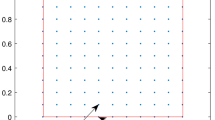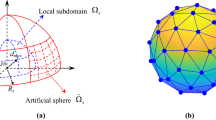Abstract
One of major difficulties in the implementation of meshfree methods using the moving least square (MLS) approximation, such as element-free Galerkin method (EFG), is the imposition of essential boundary conditions as the approximations do not pass through the nodal parameter values. Another class of meshfree methods based on the radial basis point interpolation can satisfy the essential boundary conditions exactly since its approximation function passes through each node in an influence domain and thus its shape functions possess the properties of delta function. In this paper, a coupled element-free Galerkin(EFG)-radial point interpolation method (RPIM) is proposed to enhance their advantages and avoid their disadvantages. Discretized equations of equilibrium are obtained in the RPIM region and the EFG region, respectively. Then a collocation approach is introduced to couple the RPIM and the EFG method. This method satisfies the linear consistency exactly and can maintain the stiffness matrix symmetric. Numerical tests show that this method gives reasonably accurate results consistent with the theory.
Similar content being viewed by others
References
Nayroles, B., Touzot, G. and Villon, P., Generalizing the finite element method: Diffuse approximation and diffuse elements. Computational Mechanics, 1992, 10: 307–318.
Belytschko, T., Lu, Y.Y. and Gu, L., Element-free Galerkin methods. International Journal for Numerical Methods in Engineering, 1994, 37: 229–256.
Belytschko, T., Krongauz, Y., Fleming, M., Organ, D. and Liu, W.K., Smoothing and accelerated computations in the element free Galerkin method. Journal of Computational and Applied Mathematics, 1996, 74: 111–126.
Liu, G.R. and Gu, Y.T., A point interpolation method for two-dimensional solids. International Journal for Numerical Methods in Engineering, 2001, 50: 937–951.
Liu, G.R. and Gu, Y.T., A point interpolation method based on radial basis functions. International Journal for Numerical Methods in Engineering, 2002, 54: 1623–1648.
Chen, W. and Tanaka, M., A meshless, integration-Free, and boundary-only RBF Technique. Computer Mathematics with Applications, 2002, 43: 379–391.
Fu, Z.J., Chen, W. and Yang, W., Winkler plate bending problems by a truly boundary-only boundary particle method. Computational Mechanics, 2009, 44: 757–763.
Atluri, S.N. and Zhu, T., A new meshless local Petrov-Galerkin (MLPG) approach in computational mechanics. Computational Mechanics, 1998, 22: 117–127.
Zhang, X., Song, K.Z., Lu, M. W. and Liu, X., Meshless methods based on collocation with radial basis functions. Computational Mechanics, 2000, 26: 333–343.
Liu, G.R. and Gu, Y.T., A meshfree method: meshfree weak-strong (MWS) form method for 2-D solids. Computational Mechanics, 2003, 33: 2–14.
Liu, G.R. and Gu, Y.T., An Introduction to Meshfree Methods and Their Programming. Springer, Netherland, 2005.
Lancaster, P. and Salkauskas, K., Surface generated by moving least squares methods. Mathematics of Computation, 1981, 37: 141–158.
Lu, Y.Y., Belytschko, T. and Gu, L., A new implementation of the element-free Galerkin method. Computer Methods in Applied Mechanics and Engineering, 1994, 113: 397–414.
Mukherjee, Y.X. and Mukherjee, S., On boundary conditions in the element free Galerkin method. Computational Mechanics, 1997, 19: 267–270.
Zhu, T. and Atluri, S.N., A modified collocation method and a penalty formulation for enforcing the essential boundary conditions in the element free Galerkin method. Computational Mechanics, 1998, 21: 211–222.
Gosz, J. and Liu, W.K., Admissible approximations for essential boundary conditions in the reproducing kernel particle method. Computational Mechanics, 1996, 19: 120–135.
Günther, F.C. and Liu, W.K., Implementation of boundary conditions for meshless methods. Computer Methods in Applied Mechanics and Engineering, 1998, 163: 205–230.
Lu, Y.Y., Belytschko, T. and Tabbara, M., Element-free Galerkin method for wave propagation and dynamic fracture. Computer Methods in Applied Mechanics and Engineering, 1995, 126: 131–153.
Zhang, X., Liu, X., Lu, M.W. and Chen, Y., Imposition of essential boundary conditions by displacement constraint equations in meshless methods. Communications in Numerical Methods in Engineering, 2001, 17: 165–178.
Belytschko, T., Organ, M. and Krongauz, Y., A coupled finite element-element-free Galerkin method. Computational Mechanics, 1995, 17: 186–195.
Krongauz, Y. and Belytschko, T., Enforcement of essential boundary conditions in meshless approximations using finite elements. Computer Methods in Applied Mechanics and Engineering, 1996, 131: 133–145.
Hegen, D., Element-free Galerkin methods in combination with finite element approaches. Computer Methods in Applied Mechanics and Engineering, 1996, 135: 143–166.
Xiao, Q.Z. and Dhanasekar, M., Coupling of FE and EFG using collocation approach. Advances in Engineering Software, 2002, 33: 507–515.
Gu, Y.T. and Liu, G.R., A coupled element free Galerkin/boundary element method for stress analysis of two-dimensional solids. Computer Methods in Applied Mechanics and Engineering, 2002 190: 4405–4419.
Wendland, H., Error estimates for interpolation by compactly supported radial basis functions of minimal degree. Journal of Approximation Theory, 1998, 93: 258–369.
Wang, J.G. and Liu, G.R., On the optimal shape parameters of radial basis functions used for 2-D meshless methods. Computer Methods in Applied Mechanics and Engineering, 2002, 191: 2611–2630.
Dolbow, J. and Belytschko, T., Numerical integration of the Galerkin weak form in meshfree methods. Computational Mechanics, 1999, 23: 219–230.
Author information
Authors and Affiliations
Corresponding author
Additional information
This work is supported by the National Natural Science Foundation of China (No. 11172192), the College Postgraduate Research and Innovation Project of Jiangsu Province (No. CX10B_029Z) and the Nominated Excellent Thesis for PHD Candidates Program of Soochow University (No. 23320957).
Rights and permissions
About this article
Cite this article
Cao, Y., Yao, L. & Yin, Y. New Treatment of Essential Boundary Conditions in EFG Method by Coupling with RPIM. Acta Mech. Solida Sin. 26, 302–316 (2013). https://doi.org/10.1016/S0894-9166(13)60028-2
Received:
Revised:
Published:
Issue Date:
DOI: https://doi.org/10.1016/S0894-9166(13)60028-2




